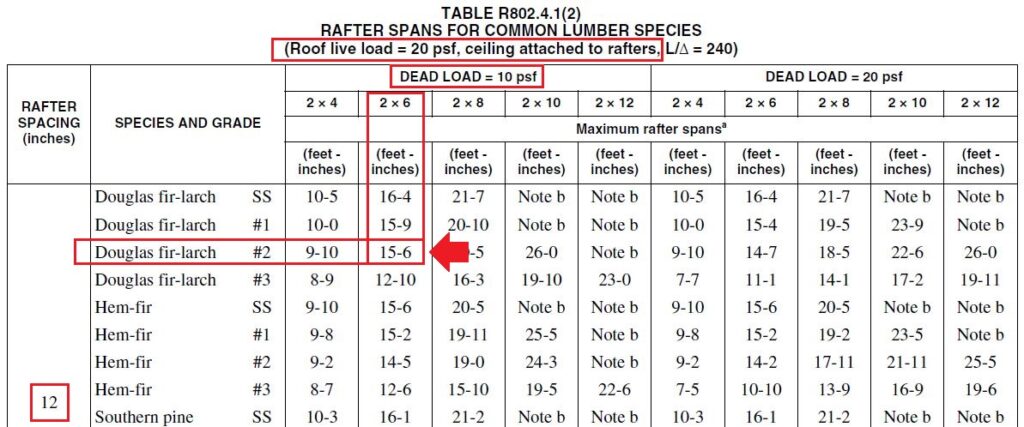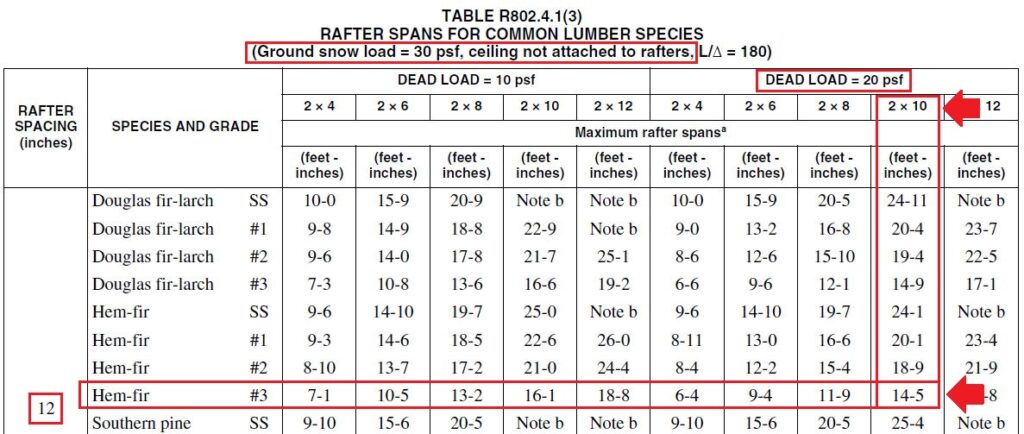Related Articles to Read:
- How to Size Floor Joists Per the IRC | Easily Explained with Examples
- How to Size Ceiling Joists Per the IRC | Easily Explained with Examples
Want to learn how to easily size roof rafters?
Chapter 8 of the 2018 International Residential Code (IRC) regulates the design and construction of roof and ceiling systems. Roof/ceiling members must be properly designed to ensure they provide adequate support as required by the loads that are imposed on them as well as making sure these loads are correctly transferred to the supporting walls and/or supporting structural elements.
The International Residential Code (IRC) recognizes two types of conventional roof and ceiling framing systems for buildings that are subject to the International Residential Code (IRC): wood framing and cold-formed steel framing.
In this post we will cover wood roof framing members, specifically roof rafters. The design and construction of wood roof rafters are found in Section R802.4 of the International Residential Code (IRC).
(Note: the table references have changed in the 2018 version of the IRC. The allowable roof rafter span tables in the 2018 version are found in section R802.4 while the tables in the 2015 version are found in section R802.5. For the purpose of consistency, this post will reference the 2018 IRC. Please be aware of which version of the IRC you are using since the allowable spans can vary.)
Section R802.4 outlines the wood roof rafter framing criteria which also includes prescriptive span tables.
In this post we will learn how to correctly size a roof rafter based on its span, spacing and species of wood used.
Fun Tip: To learn the difference between the International Residential Code (IRC) verses the International Building Code (IBC), be sure to check out this POST.
Roof Rafter Loads
Wood roof rafters are sized based on one of eight tables found in the code. These span tables list allowable roof rafter spans for common lumber sizes based on what design load scenario is applied. Before we look at these tables, we need to make sure the correct design loads are determined prior to selecting the correct table.
The code recognizes 2 types of loads that are applied to roof rafters: Live Loads and Dead Loads.
Live loads are defined by the code as follows:
Loads produced by the use and occupancy of the building or other structure. This does not include construction or environmental loads.
Dead loads are defined by the code as follows:
The weight of the materials of construction incorporated into the building, including but not limited to walls, floors, roofs, ceilings, stairways, built-in partitions, finishes, cladding, and other similarly incorporated architectural and structural items, and fixed service equipment.
Roof Rafter Span Tables
As mentioned above, the span tables within the code list the allowable roof rafter spans for common lumber sizes based on what design load scenario is applied.
According to Section R802.4.1, roof rafters are to be sized based on Tables R802.4.1(1) through R802.4.1(8). It is very important to select the correct table.
Now in order to select the correct table, we must understand 2 things: Which Live Load is to be use and whether or not the ceiling joists are attached to the roof rafters.
We touched on the loads earlier but let us go over why it is important to know if the ceiling joists are attached to the roof rafters or not.
According to Section R802.5.2 each roof rafter must be tied across the structure via ceiling joists or rafter ties. When the ceiling joists are attached, they act as the tie. When they run in the opposite direction creating a scenario where they are not attached to the rafters, then rafter ties can be used to achieve the tie requirement.
This connection is important because it resists the horizontal thrust from gravity loads and rafter thrust caused by the uplift from wind loads.
Using either a rafter tie or the ceiling joists themselves can vary slightly in the size of the roof rafter used which is why the code creates two types of span tables. One for when ceiling joists are used as the ties and one when they are not used, thus requiring the rafter ties.
Another thing to note is that the roof rafter span tables are limited to the ceiling joists or rafter ties being located at the top plate or within the lower third of the attic space. If the ceiling joist is not located at the top plate but located within the lower third of the attic, a rafter space adjustment factor is applied to the rafter to account for the additional stress on the roof rafter due to the tie or ceiling joist being located heigher up in the attic. This adjustment factor is found in footnote ‘A’ within any of the roof rafter space Tables R802.4.1(1) through R802.4.1(8).
However it is important to note that if the ceiling joists or rafter ties are located higher up in the attic as to where they would exceed the one-third requirement, then the span tables can NOT be used and instead would require the roof rafters to be designed in accordance with accepted engineering practice.
So basically if the design loads are exceeded or the ceiling joists or rafter ties are located more than one-third into the attic, the design of the roof rafters are outside the prescriptive standards of the tables and at that point they must be designed in accordance with accepted engineering practice.
As you can see, unlike ceiling joists or floor joists, roof rafters have many factors that must be taken into account when selecting the correct size.
Now with all that out of the way, lets take a look at those tables to learn how to correctly size roof rafters using the prescriptive standards:



For simplicity, only the table headers are shown above. The table header must be understood first before we can correctly select the right table for sizing the roof rafters. Each table is labeled. As you can see Table R802.4.1(1) and Table R802.4.1(2) are both designed for rafters having a roof live load of 20 psf, however the first one is for ceilings not attached to rafters while the second one is for ceilings attached to rafters.
Remember what was said earlier. Rafters must be tied, so if they are not tied to the ceiling joists, then they would require rafters ties to be installed.
As for Tables R802.4.1(3) through R802.4.1(8), you have different snow loads being applied to the roof while applying the same principle of the joists either being attached or not. For simplicity, only Table R802.4.1(3) is shown above to indicate the change in the live load within the header.
Again the Tables are to be used only for the live load and dead loads indicated within the tables. They can NOT be used for design loads that are beyond these prescriptive tables.
Now lets go over what information is found on the tables.
The tables provide the following information on them:
- Roof Rafter Spacing in inches (12, 16, 19.2, 24)
- Species and Grade of Lumber
- Various Lumber Size Options (2×4, 2×6, 2×8, 2×10, 2×12)
- The maximum roof rafter span based on the lumber size, species/grade, and spacing used.
Now, in order to correctly size roof rafters, lets take a look at a few examples.
How to Size Roof Rafters
Sizing Roof Rafters – Example 1
Question: Where the ceiling is attached to the rafters, what is the maximum allowable span of a 2×6 Douglas fir-larch #2 roof rafter spaced 12 inches on center supporting a roof live load of 20 psf and a dead load of 10 psf?
First step, lets collect all the given information within the question:
- Ceiling attached to rafters and a live load of 20 psf: Use Table R802.4.1(2)
- Roof Rafter Spacing: 12 inches
- Species and Grade: Douglas fir-larch #2
- Dead load: 10 psf
- Lumber Size used: 2×6
Now lets find the maximum allowable span for a 2×6 member given the above scenario:

Therefore given the above example, the maximum allowable span for a 2×6 member is 15′-6″.
Sizing Roof Rafters – Example 2
Now lets try another example, but this time a span will be given and you must select the correct size lumber to be used given the following scenario:
Question: When the ceiling is not attached to the rafters and where Hem-fir #3 roof rafters are to be spaced 12 inches on center supporting a snow load of 30 psf and a dead load of 20 psf, what is the minimum allowable rafter size when required to span 14′-0″ in length?
First step, lets collect all the given information within the question:
- Ceiling not attached to rafters and a snow load of 30 psf: Use Table R802.4.1(3)
- Roof Rafter Spacing: 12 inches
- Species and Grade: Hem-fir #3
- Roof Rafter Span: 14′-0″
Now lets find the minimum allowable rafter size given the above scenario:

Therefore given the above example, the minimum allowable rafter size for Hem-fir #3 lumber spanning 14′-0″ is a 2×10 since it can span 14′-5″. A 2×8 member for example cannot be used since it can only span 11-9″.
To Learn more about the design and construction of wood roof framing, be sure to check out Section R802 of the 2018 International Residential Code (IRC).
Fun Tip: To learn how to easily size ceiling joists, be sure to check out this POST.
Hopefully given the above examples you can find it easier to size wood roof rafters per the Tables within the International Residential Code.
In conclusion, lets take a quick second to answer some common frequently asked questions related to roof rafters.
What is the standard size of a roof rafter?
The standard size of a roof rafter can really be any size as long as it is not smaller than the minimum size as required per the code. The minimum size of a roof rafter is determined using the prescriptive tables found within Chapter 8 of the International Residential Code (IRC).
How far apart should roof rafters be?
The spacing of roof rafters is just one of the components used to determine the minimum size of the roof rafter. Per the prescriptive tables found in Chapter 8 of the International Residential Code (IRC), the standard roof rafter spacing used is 12, 16, 19.2, or 24 inches on center.
How far can a roof rafter span?
The maximum span of a roof rafter is based on the size, spacing and species of wood used along with the design loads applied to the roof system and whether the ceiling is attached to the rafter or not. The prescriptive tables found in Chapter 8 of the International Residential Code (IRC) can be used to determine the maximum span of a roof rafter.
How do you measure roof rafters?
According to Section R802.4.1 of the 2018 International Residential Code, rafter spans shall be measured along the horizontal projection of the rafter.
.
* Reference Source – 2018 International Residential Code – [Buy on Amazon]
Related Articles to Read:
